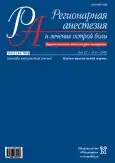Comparative evaluation of the use of a single and extended blockade of shoulder splitting at arthroscopic operations on the shoulder
- Authors: Krylov S.V.1,2, Pasechnik I.N.2, Sotnikov A.V.1, Timchenko D.О.1
-
Affiliations:
- National Medical Research Center of Traumatology and Orthopedics NN Priorov of the Ministry of Health of Russia
- Central State Medical Academy UD of the President of the Russian Federation
- Issue: Vol 12, No 4 (2018)
- Pages: 211-216
- Section: Original articles
- URL: https://journals.rcsi.science/1993-6508/article/view/61287
- DOI: https://doi.org/10.17816/1993-6508-2018-12-4-211-216
- ID: 61287
Cite item
Full Text
Abstract
In the last decade, there has been a steady increase in the number of arthroscopic operations on the shoulder joint. The development and introduction of arthroscopy made it possible to improve the quality of surgical care for injuries of the shoulder joint. However, despite the minimally invasive technique, the issues of postoperative analgesia in this type of surgical interventions have not been fully developed. The article discusses the possibility of using single and prolonged conductive anesthesia in patients with arthroscopic operations on the shoulder joint.
Full Text
##article.viewOnOriginalSite##About the authors
Sergey V. Krylov
National Medical Research Center of Traumatology and Orthopedics NN Priorov of the Ministry of Health of Russia; Central State Medical Academy UD of the President of the Russian Federation
Author for correspondence.
Email: doc087@inbox.ru
assistant of the Department of Anesthesiology and Reanimatology,anesthesiologist-resuscitator of the Department of Anesthesiology and Reanimation
Russian Federation, MoscowI. N. Pasechnik
Central State Medical Academy UD of the President of the Russian Federation
Email: doc087@inbox.ru
Russian Federation, Moscow
A. V. Sotnikov
National Medical Research Center of Traumatology and Orthopedics NN Priorov of the Ministry of Health of Russia
Email: doc087@inbox.ru
Russian Federation, Moscow
D. О. Timchenko
National Medical Research Center of Traumatology and Orthopedics NN Priorov of the Ministry of Health of Russia
Email: doc087@inbox.ru
Russian Federation, Moscow
References
- Akimkina A.M., Znamensky I.A., Goncharov E.N., Chibisov S.M., Lisachenko I.V., Yumatova E.A. Possibilities of magnetic resonance imaging in the diagnosis of injuries of the shoulder joint in acute injury. Radiologiya. 2010; 2: 7–16.
- Karasev Ye.A., Karasev, T.Yu. Arthroscopic stabilization of the shoulder joint with the usual dislocation of the shoulder. Genii ortopedia. 2014; 1: 5–8.
- Sukhin Yu. V., Logay V. A. Development of a computer-navigation system for the treatment of habitual dislocation of the shoulder. Uchenie zapiski Petrozavodskogo gosudarstvennogo universiteta. 2015; 147 (2): 8-35.
- Hughes M.S., Matava M.J., Wright R.W., Brophy R.H., Smith M.V. Interscalene brachial plexus block for arthroscopic shoulder surgery: a systematic review. J. Bone Joint Surg. Am. 2013; 95 (14): 18–24.
- Iyengar J.J., Samagh S.P., Schairer W., Singh G., Valone F. H. 3rd, Feeley B. T. Current trends in rotator cuff repair: surgical technique, setting, and cost. Arthroscopy. 2014; 30 (3): 284–8.
- Ovechkin A.M. Chronic postoperative pain syndrome is an underwater stone of modern surgery. Regionarnaia anesthesia i lechenie ostroi boli. 2016; 10 (1): 5-18.
- Beecroft С.L., Coventry D.M. Anaesthesia for shoulder surgery. Contin. Educ. Anaesth. Crit. Care Pain. 2008; 8 (6): 193–8.
- Lee H.-Y., Kim S. H., So K. Y., Kim D. J. Effects of interscalene brachial plexus block to intra-operative hemodynamics and postoperative pain for arthroscopic shoulder surgery. Korean J. Anesthesiol. 2012; 62 (1): 4–30.
- Karels C.H., Bierma-Zeinstra S.M., Verhagen A. P., Koes B. W., Burdorf A. Sickness absence in patients with arm, neck and shoulder complaints presenting in physical therapy practice: 6 months follow-up. Man. Ther. 2010; 15 (5): 476–81.
- Verelst P. Respiratory impact of analgesic strategies for shoulder surgery. Reg Anesth Pain Med. 2013; 38: 50–3.
- Fredrickson M.J. Neurological complication analysis of 1000 ultrasound-guided peripheral nerve blocks for elective orthopaedic surgery: a prospective study. Anaesthesia. 2009; 64: 836–44.
- Gelfand H.J. Analgesic efficacy of ultrasound-guided regional anesthesia: a meta-analysis. J. Clin. Anesth. 2011; 2: 90–6.
- Salviz E. A., Xu D., Frulla A., Kwofie K., Shastri U., Chen J. et al. Continuous interscalene block in patients having outpatient rotator cuff repair surgery: a prospective randomized trial. Anesth. Analg. 2013; 117 (6): 85–92.
- Levin, P. The opioid epidemic. J Am Acad Orthop Surg. 2015; 23: 36–7.
- Pasechnik I.N. Fast Track program in surgery: the role of postoperative analgesia. Anestesiologia i reanimatologia. 2015; 15: 49–53.
- Nadeau M-J. Ultrasound-guided regional anesthesia for upper limb. J Can Anesth. 2013; 60: 304–20.
- Duggan E. Minimum effective volume of local anesthetic for ultrasound-guided supraclavicular brachial plexus block. Reg Anesth Pain Med. 2009; 34: 215–8.
- Lee J.H. Ropivacaine for ultrasoundguided interscalene block: 5 mL provides similar analgesia but less phrenic nerve paralysis than 10 mL. Can J Anesth. 2011; 58: 1001–6.
Supplementary files






